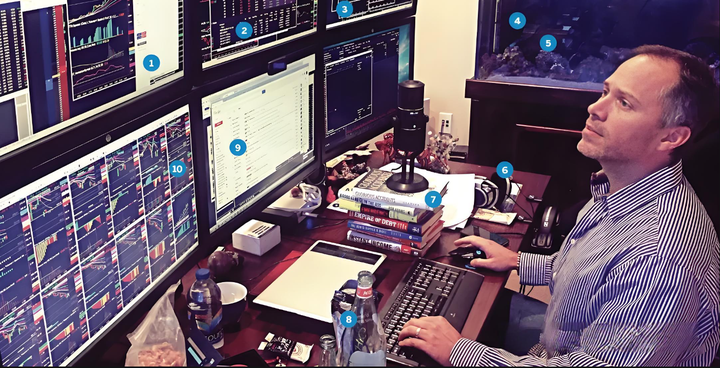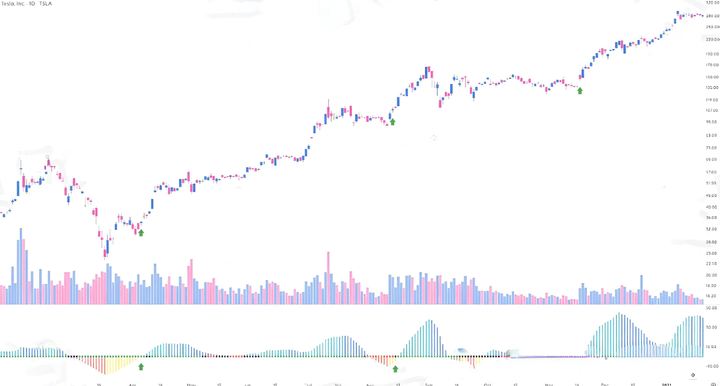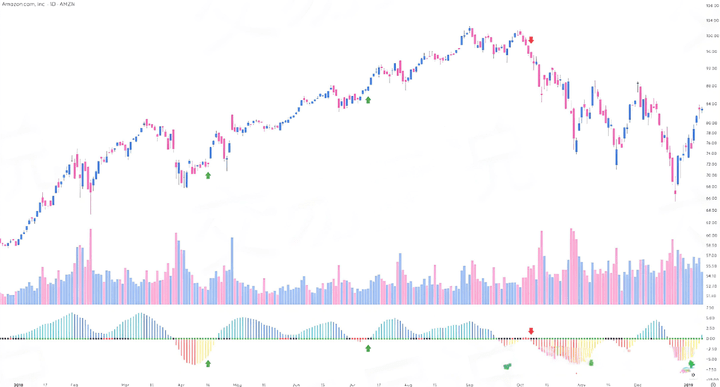Once you grasp cryptocurrency trading, life feels enlightened! Ten years ago, I stepped into the cryptocurrency world, and like most retail investors, my gains and losses seemed purely based on luck, with no discernible pattern. However, after spending a few years in the cryptocurrency market, through continuous learning and absorption, along with the sharing and guidance of mentors and seniors, I gradually found my footing and developed my own investment system!

I have been in the cryptocurrency circle full-time for eight years! My assets are in the tens of millions, withdrawing 100,000 yuan from my account every month has no effect, living leisurely and freely, without deceit or intrigue, living the life I want.
Today, I want to share the story of a trader! Let's get straight to the point:
How John Carter Started His Trading Journey
In my senior year of high school, I worked at a cookie shop in a mall, earning minimum wage. After a while, I saved up $1,000. One night, I came home and saw my dad and his friends gathered around the table discussing call options for Intel. I had no idea what 'call options' or 'options' were, and I didn't even know what 'Intel' was, but I was deeply fascinated.
I took out my saved $1,000, and they helped me place a trade with 10 contracts. A few weeks later, I got back that $1,000 plus an additional $800. I wasn't even sure how that trade worked, but I was already captivated. I realized I could make money based on ideas, not just with my hands.
This early success made John Carter addicted to trading, and he spent years refining his strategy. However, his path to success was not smooth; he experienced several cycles of sharp rises and falls, including one instance where he lost $150,000 just before buying a house.
This painful experience made him deeply aware of the importance of risk management, and it became the cornerstone of his entire trading strategy.
Early Key Lessons
◎ Risk Management is Crucial - Early mistakes taught him that structured risk control is essential.
◎ Market Participation is Key - Real big opportunities only happen a few times a year, and traders must always be prepared.
◎ Emotional Control is Also Important - Inspired by Mark Douglas's (Trading in the Zone), he learned to separate emotions from trading decisions.
John Carter's Trading Strategy: Squeeze Pattern
One of Carter's most well-known strategies is the 'Squeeze' - a volatility-based pattern used to identify the compression state of prices before a breakout. Through this strategy, traders can enter early before significant market movements occur, greatly increasing their chances of success.
What is Squeeze?
Squeeze in options trading refers to a phenomenon where the market experiences accelerated one-sided fluctuations due to one side of the position being forced to liquidate.
The core concept of the Squeeze strategy is 'low volatility breeds high volatility.' When a stock is consolidating horizontally and its price is compressed within a narrow range, it is actually accumulating momentum.
Once momentum is released, the price usually shows a significant one-sided trend:
◎ When the Bollinger Bands contract within the Keltner Channels, it indicates that the market is in a low volatility state, which is the 'Squeeze.'
◎ A red dot appears on Carter's 'Squeeze Indicator,' signaling a high-probability trading opportunity.
◎ Momentum indicators help determine whether the breakout direction is up or down.
◎ When the Bollinger Bands begin to expand and the Squeeze 'triggers,' prices usually explode rapidly in one direction.

How to Identify the Optimal Squeeze Pattern?
Not all Squeezes are worth trading. John Carter considers multiple factors to filter high-probability opportunities:
◎ Price is above the 21-day EMA (Bullish Pattern) or below (Bearish Pattern).
◎ Moving Averages Bullish Alignment (Bullish when: 8 > 21 > 34 > 55 > 89 EMA).
◎ The momentum histogram begins to turn in the expected direction.
◎ Squeeze continues to show 5 to 8 red dots (indicating momentum is fully accumulating).
◎ Individual stocks show clear relative strength compared to the broader market.
How John Carter Trades Squeeze?
John Carter avoids chasing prices after a breakout, instead entering positions before the market starts to move. This not only helps better manage risks but also seizes opportunities from asymmetrical returns.
1. Best Entry Point: Buy when the price pulls back to the 21-day EMA during the Squeeze.
2. Entry Confirmation: The momentum indicator shifts towards the expected breakout direction, serving as an entry signal.
3. Secondary Entry: Enter when the price pulls back to the breakout position after Squeeze is triggered.
Before the Squeeze triggers, place limit orders near the 21-day EMA, needing strong confidence support and strict stop losses. This 'early entry' method can achieve maximum profit potential while carrying lower risk.
Waiting until the first strong momentum candlestick closes to enter, while relatively safer, may sometimes miss part of the larger trend.
Profit Exit Strategy:
John Carter usually takes partial profits when the market strengthens.
◎ First Target: +2 ATR (Average True Range).
◎ Second Target: +3 ATR, partial profit-taking.
◎ Final Goal: Retain a portion of the position and wait for a larger market move to unfold.
If the Squeeze does not successfully trigger or momentum weakens, he will exit early to stop losses and avoid expanding losses.
John Carter's Classic Trading Case
Carter has had many impressive large successful trades, three of which stand out for their huge profits, excellent risk management, and precise execution.
Tesla - A Legendary Trade that Netted $14 Million
In 2020, this trade on Tesla was a classic case for Carter, bringing him over $14 million in profits.
Trading Background:
⊙ After a significant rise, Tesla began to consolidate.
⊙ Carter discovered a Squeeze pattern on the daily chart, indicating an imminent breakout.
⊙ Price momentum is strong, moving averages are bullishly aligned, and the structure is robust.
Specific Operations:
⊙ Carter did not directly buy stocks but chose deep-in-the-money call options for leverage.
⊙ He used long call spread strategies to reduce risk and optimize returns.
⊙ Although he had a large position, he strictly adhered to risk control rules throughout the trading process.
Stock Code: TSLA
Company: Tesla, Inc.
Date: 2020

Trading Results:
⊙ Tesla rose strongly as expected, and Carter gradually reduced his position to lock in profits.
⊙ Ultimately, he achieved a profit of $14 million, making this trade one of the brightest achievements in his trading career.
Amazon - Squeeze Pattern After Earnings Release
Amazon is one of Carter's favorite stocks to trade. In 2018, after a quarterly report was released, he executed a textbook Squeeze trade.
Trading Background:
⊙ Amazon released robust financial data, but the stock price did not immediately rise.
⊙ A clear Squeeze pattern appeared on the 30-minute candlestick chart, indicating a breakout was about to occur.
⊙ Carter noted that implied volatility remained high, leading to higher costs for option buyers.
Specific Operations:
⊙ He chose to sell put spreads to take advantage of Amazon's potential upward trend.
⊙ Compared to directly buying call options, selling spread combinations allows one to collect premiums while controlling downside risk.
⊙ His risk was predetermined, and the stop loss was set below the breakout level, strictly controlling potential losses.
Stock Code: AMZN
Company: Amazon.com
Date: 2018

Trading Results:
⊙ Amazon's stock price rose sharply, successfully breaking the Squeeze pattern.
⊙ Carter closed his position in a few days, achieving six-figure profits.
Netflix - Capturing Major Reversal Opportunities
In 2019, Carter's trade on Netflix was a perfect demonstration of 'buying the dip.'
Trading Background:
⊙ Netflix was in a strong downtrend, with its stock price approaching a key support level.
⊙ Carter observed that institutional buying was active (judged by a surge in trading volume).
⊙ A Squeeze pattern appeared on the 4-hour chart, indicating a potential reversal is about to happen.
Specific Operations:
⊙ Carter bought call options, expecting the stock price to rebound.
⊙ Due to counter-trend trading, he took smaller positions.
⊙ He set the stop loss below the support level, strictly controlling risk.
Stock Code: NFLX
Company: Netflix, Inc.
Date: 2019
DSF Trading Results:
⊙ Netflix's stock price rebounded significantly, validating Carter's judgment.
⊙ He gradually reduced his position, locking in profits as the stock price rose.
⊙ This trade generated over $500,000 in just a few days.
How Carter Manages Trading Risks
John Carter is known for being able to take calculated risks while protecting trading capital. He understands that risk is inevitable in trading, but the key is to control risk, which is the biggest difference between successful traders and those who blow up their accounts.
His risk management methods mainly include position control, portfolio hedging, moving stop losses, and gradual exits.
Risk Management Philosophy
● Position Control - Control each trade's risk to 5%, but for extremely high-quality (A+) trading opportunities, the risk can be raised to 10%.
● Portfolio Hedging - Buy put options on the S&P 500 index (SPX) to protect long positions.
● Moving Stop Loss - Exit in a timely manner when trading conditions no longer meet, even if it results in a loss.
● Gradual Exit - Reduce risk exposure by gradually locking in profits.
💡 The Biggest Lesson: Never Go All In
Carter once nearly lost all his funds by betting everything on an options trade before a major market event. Since then, he has never put all his chips on one outcome.
By following these principles, Carter was able to survive in the market for a long time and seize the best trading opportunities.
Respond to market fluctuations like a professional.
John Carter excels at trading in highly volatile markets, where significant price fluctuations create substantial trading opportunities. However, high returns come with high risks, and Carter reminds traders to learn to cope with volatility, avoiding emotional trading and major losses.
If managed properly, market fluctuations can bring substantial returns; conversely, without a plan, volatility can destroy accounts. Carter developed specific strategies to maintain discipline, protect profits, and capitalize on intense price fluctuations.

Surviving in the Crazy Market After the Pandemic in 2020
In 2020, Carter's aggressive trading on Tesla led to a surge in his account, but the volatility was extreme - one month he gained 300%, the next month he dropped 33%.
To cope with volatility, he took the following measures:
● Maintain a Neutral Mindset - Do not let profits or losses affect your emotions.
● Regularly Withdraw Profits - Prevent Overtrading, Ensure Long-term Gains.
● Multi-Account Operations - One part of the account trades aggressively while the other part engages in passive investment.
For traders looking to survive in unpredictable markets, these strategies help transform chaos into opportunity while protecting capital for long-term growth.#BTC重返12万
Summary
John Carter's trading experience is highly instructive for traders of all levels. He emphasizes that mindset is key; the market will constantly test your discipline, and it is important to remain calm and avoid emotional reactions. Meanwhile, he advocates small risks for large returns, reasonably controlling positions, and hedging to avoid wiping out all profits due to a single mistake.
He also reminds everyone to always operate according to the trading plan and not let temporary emotions lead them astray. The market always has cyclical changes; while extreme market conditions like in 2020 are rare, there will always be good high-probability opportunities each year. The key is to patiently wait. Lastly, don't forget to regularly take profits; trading is not a game, and making money is the most practical goal.#ETH突破4300
Finally, I would like to summarize a few insights to help everyone avoid some detours! I hope this is helpful for everyone.
Position Management - A Key Strategy for Successful Cryptocurrency Investment
In cryptocurrency investment, excellent position management means you have surpassed most participants. Position management directly affects your risk level, average holding cost, and final profit level. Its importance is second only to choosing the right investment direction and maintaining a good mindset.#币安Alpha上新
1. Definition and Importance of Position Management
Position management refers to the process of investors planning and managing the phases of entering the market, building, increasing, reducing, and clearing positions. Effective position management can not only avoid risks but also minimize losses and maximize profits. Many traders fail primarily because they rely too much on market analysis while neglecting the importance of position management. In fact, market analysis is merely the foundational work, and what truly determines win or loss is the follow-up operations after buying, especially position management, including capital management and risk control.
2. Explanation of Position Concept
Position refers to the ratio of the total amount an investor uses for trading to the amount already invested. For example, if you have 100,000 yuan for trading and have invested 30,000 yuan in digital currency, your position is 30%, or three layers. This buying behavior is called opening or building a position. Furthermore, terms like half-position, light position, heavy position, adding position, reducing position, clearing position, holding position, and bottom position represent different funding situations.
Three, Six Basic Principles of Position Management
Never go all in, ensuring sufficient backup funds. Just like having a reserve force on the battlefield, not going all in can avoid passive situations brought by market fluctuations, leaving room to cope with unknown risks.
Trade in batches, diversify risks, lower costs, and increase returns. Batch operations allow you to have a lower average purchase cost, thus increasing returns.
In a weak market, maintain a light position; in a bull market, hold a heavier position. In a bear market, do not exceed half a position, while in a bull market, the maximum position is suggested to be eight layers, reserving 20% of short-term or backup funds for unexpected situations.
Go with the market, flexibly adjust your position. Depending on market changes, timely increase or decrease positions, such as adding positions when the market is favorable and not easily increasing positions when the market is unclear.
In a sluggish market, it is advisable to stay in cash and wait for opportunities. During specific periods, such as the end of a bull market, the beginning of a bear market, or when the bottom is not stable, it may be wise to temporarily stay in cash or lightly hold. However, staying out of the market for too long can lead to a loss of sharp market perception.
Optimize the holding structure and eliminate weak cryptocurrencies. Regardless of whether the market rises or falls, volatility means opportunities exist. Timely adjustments to the holding portfolio are necessary to discard poorly performing cryptocurrencies and capture more market opportunities.
The above six principles apply to both spot trading and contract trading.
The core technique of position management is to trade in batches, meaning dividing funds and gradually building up, adding to, or reducing positions. Batch operations can be completed in a short time or executed gradually over a longer period.
Understanding and mastering the above position management principles and methods, whether in spot building or contract building, will provide you with clear direction and strong support on your cryptocurrency investment journey.
No matter how diligent a fisherman is, he won't go out to sea during a storm but will carefully guard his boat. This season will pass, and a sunny day will come! Follow me to learn both fishing and how to fish. The cryptocurrency door is always open; you can only have a smooth life by going with the trend. Save this and keep it in mind!

